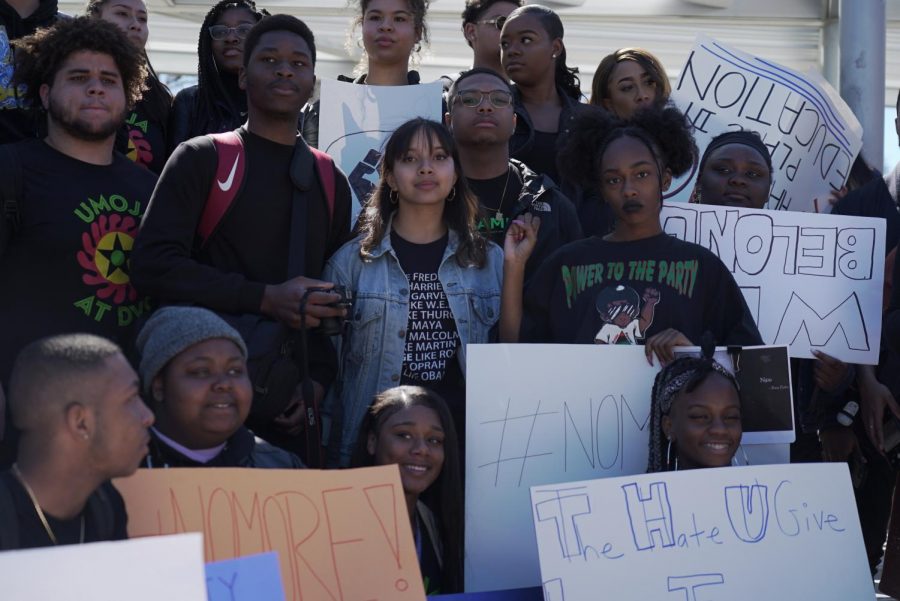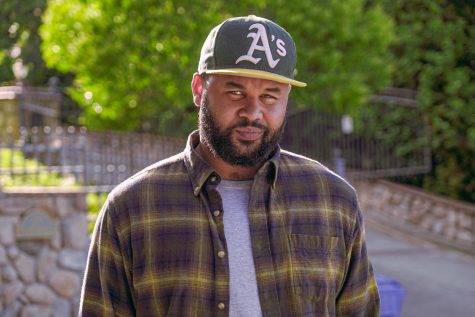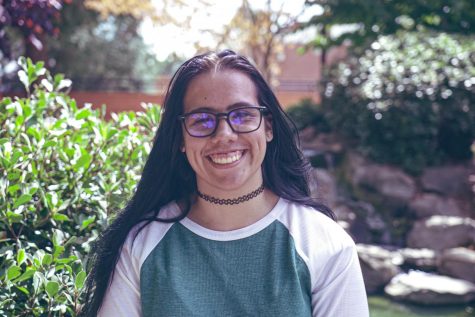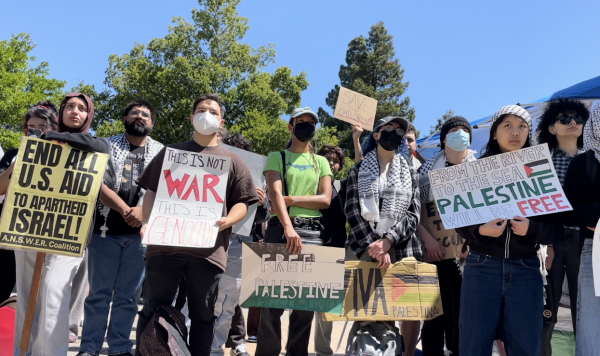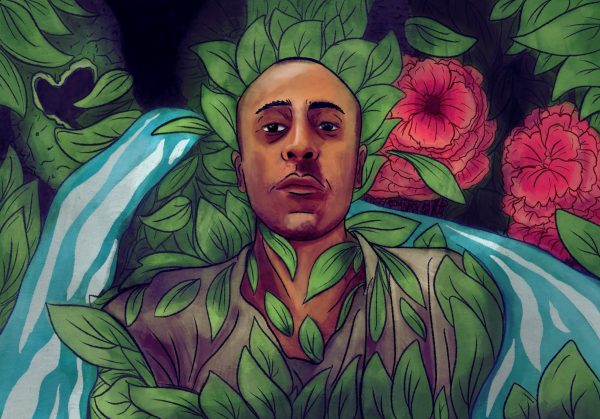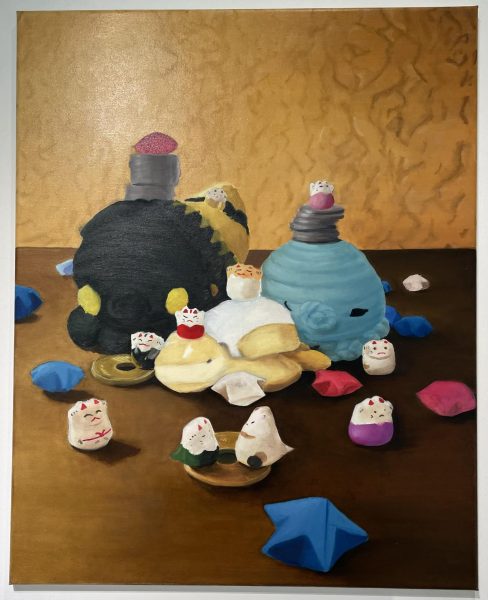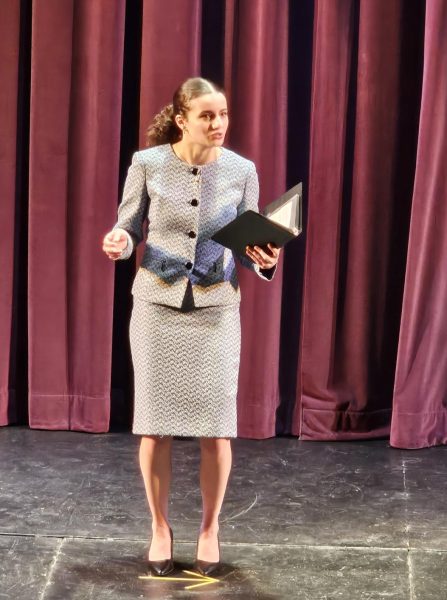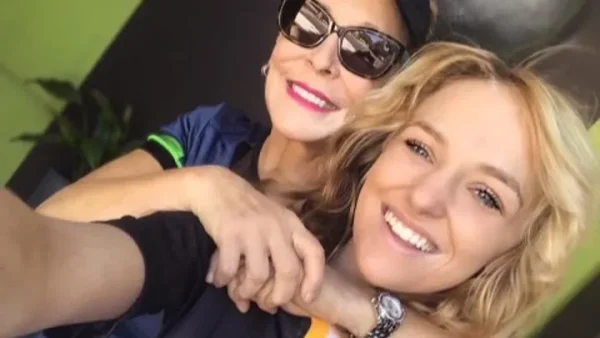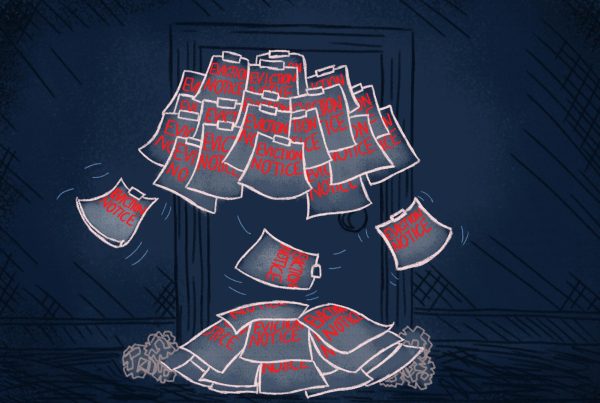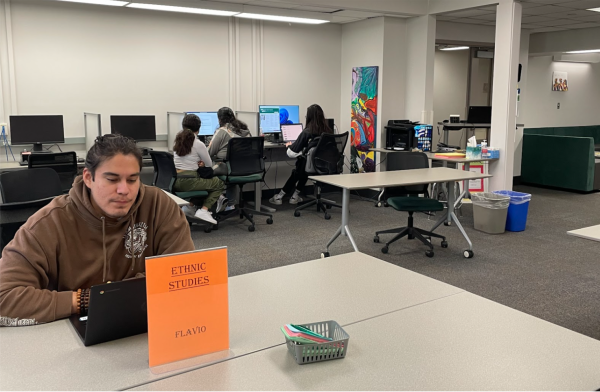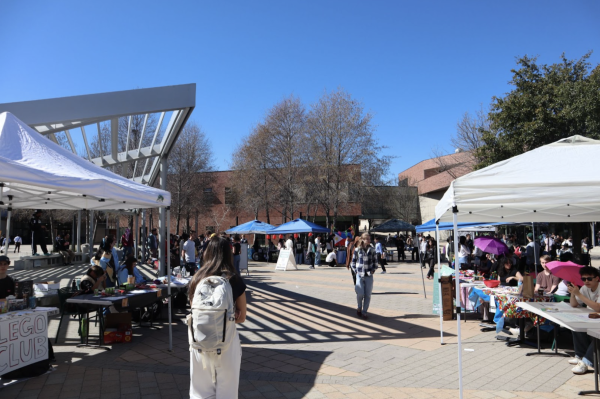Students of color stand up against racist hate
Students of color and others gathered yesterday during a walkout, to voice the lack of communication from president Susan Lamb–regarding racial slurs and a lynching illustration, found in the Engineering and Technology building. From left to right starting at the top: Brenda Ortiz, Ohemaa Asare, Halea Monigan, Tre Stone, Sadé Creel. 2nd row: Juwan Roquemore, Sam, Vanessa Galang, Bishari Taylor, Kiana Stewart, Haley Hall. 3rd row, at the bottom: Lee West, Daechelle Harper, J’Dah Christian and Sam Kanyika (Ethan Anderson/The Inquirer)
March 14, 2019
Hundreds of Diablo Valley College students mobilized to voice their opinions about the graffiti found inside a men’s bathroom of the Engineering Technology building, which consisted of racial slurs and a picture encouraging the lynching of students of color.
“I am ashamed in my school, I feel disrespected on campus,” said student Djoina Lockett. “This is a conversation that we need to discuss.”
On Wednesday, students of color confronted the DVC administration, president Susan Lamb, and other faculty members who attended the college-wide walkout that culminated in the Commons at 11 a.m.
“They say there’s no room for us n***ers working for the trades. They say there’s no room for us here… How does that make us feel?” Vanessa Galang said, who was one of several DVC student organizers that spoke out to the crowd. “This thing has happened, and nobody knew about it. It is telling us that we do not belong here. People are saying that we do not belong here. Why do I not belong here with you?”
After Galang addressed a couple of students who claimed the incident was a singular event, Lamb approached the microphone with a smile for her opening statement; only after Galang requested a meeting with the president of DVC–the demand resonated with the crowd.
“I take this very seriously,” said Lamb, as many students began to voice their disagreement. “I am not here to talk, I am here to listen, and I am open to conversations going forward. I think this is an ongoing conversation. This isn’t one conversation, it is a conversation that is about this community, about this country and the way we move forward through conversation.”
Some students were reluctant to listen to Lamb and expressed skepticism. One student yelled in response, “Counseling services are not enough.”
President Lamb responded by asking for suggestions from the student body to improve the situation. She stood in the center of the crowd, surrounded by students angered by the hate-filled sentiments left by a nameless individual. The student organizers of the event (Galang, Lockett, Arieal Young, Rhiana Burton and others) took the opportunity to present a list of demands. Galang stood in front of Lamb and began to list them off. The demands including anti-racist and workshops for faculty and staff, transparency from administration, and mandatory meetings between Lamb and students.
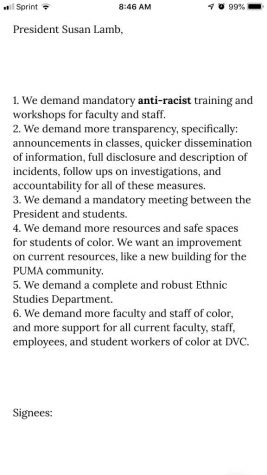
The full list of demands composed by students. (Photo courtesy of Vanessa Galang).
“I am taking these demands very seriously. Some of them are within my purview and some of them are faculty issues,” said Lamb in response. “Faculty has certain roles within the college, for example, Ethnic Studies Departments and curriculum, that is part of faculty’s roles. That is not a president’s decision, though I do take these very seriously. I will work with the college community, which involves staff and classifies and management and faculty, to have conversations around these, and see which ones they might be willing to move forward.”
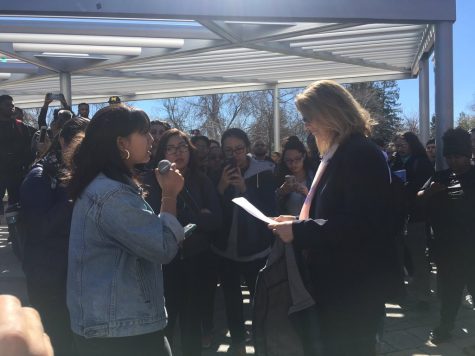
DVC student Vannessa Galang speaking to Lamb in the commons regarding the list of demands on March 13. (Emma Hall/The Inquirer).
After the discussion between Galang and Lamb, the president took to the side of the demonstration and observed the rest of the rally. Students then took center stage to unite as a community.
“Us coming together, this is how change happens.” said student Bryan Kelsch.
Toward the end of the walkout, Burton looked out into the crowd at hundreds of her peers. As she reviewed her phone, holding a microphone in her other hand, she began to give a speech.
“It is time to act in solidarity and unity. If you are hearing me right now I want you to grab your brothers or your sisters hand that’s standing right next to you. And tell them it’s time to unite,” said Burton. “I don’t care what skin they have, whom they chose to love, or what language they speak because we are here together. Because right now we are going to make a place where we can free, free of systematic oppression, free of stereotypes, free of the hatred. Because when we unite together we are coming from a place of love. And I believe that is the most powerful thing that we can all do together. When we stand together we are making a barrier that can not be broken.”
After the walkout ended there was a smaller, pre-planned solidarity circle, which had students and faculty discuss their concerns moving forward. Numerous faculty members explained their involvement with the social justice movement–some of whom, have been heavily involved with the cause.
“I know a lot of people on this campus that are behind student success and I know they want the best things for students, but I think the only way we can figure out what’s best for students are, is if the students are at the center of those debates and conversations, not on the poriferous window dressing,” said Mickey Huff, co-chair of the history department and social science professor. “And quite frankly, what I’ve seen here in the last several years has been way more of that and not enough of the other way around.”
During the circle, students and faculty alike began to clap for Huff’s insight. The attendees expressed a sense of urgency and the need for something to change moving forward.
Although it isn’t well-known, there is a place on campus for students of color to feel safe and be part of a family-like community: The Puma Center serves as that current safe space, but students explained that it is in need of a revamp. Many students are unaware of the building and the programs it provides. Inside, the community has programs such as Puente, Umoja, and MESA Achievement. These vital programs provide students of color with study rooms, computer labs, printing, tutoring, workshops, counseling, and program coordinator and faculty office hours. The main goal of the Puma Center is to cultivate success within academia.
According to attendees, an in-person conversation between students and president Susan Lamb is critical; this sentiment was expressed during both events. Administration members agree. They said the conversation is how they will begin to take action in light of student demands.
“What I understood from the talk this morning was certainly that she intends to sit down with students to discuss demands,” said Vice President of Instruction Mary Gutierrez.





































































